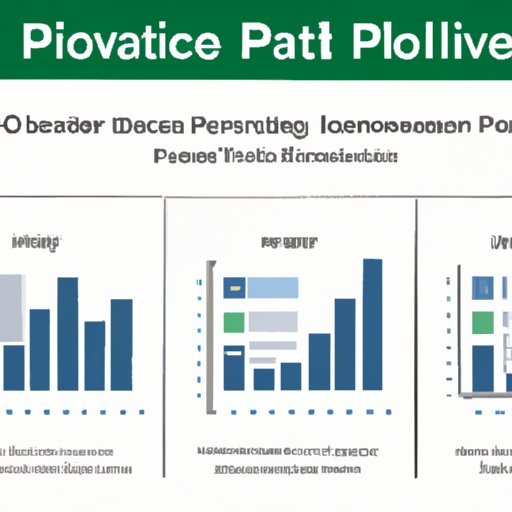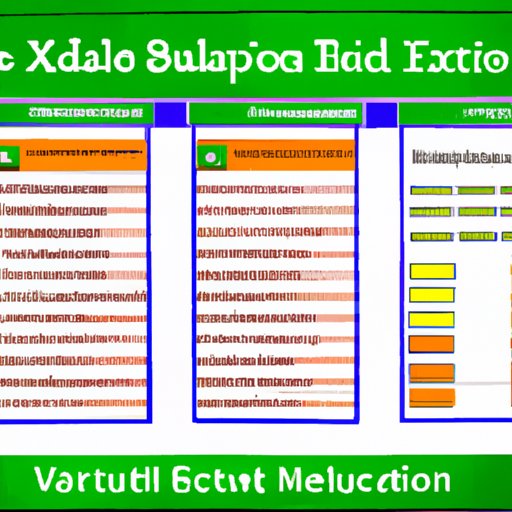Introduction
Excel is one of the most popular spreadsheet programs used by businesses and individuals to organize, analyze, and present data. Despite its powerful features, Excel can be tedious to use when dealing with large amounts of data or complex calculations. Fortunately, there are ways to automate these processes to make them more efficient and less error-prone. In this article, we will explore how to automate processes in Excel, including creating macros and Visual Basic for Applications (VBA) scripts, utilizing Excel functions, using pivot tables, applying conditional formatting rules, and implementing data validation rules.
Create a Step-by-Step Guide for Automating Processes in Excel
The first step in automating any process in Excel is to break down the process into individual steps. This will help you determine which tools you need to use and what inputs and outputs are necessary. Once you have a clear understanding of the process and its components, you can decide which tools are best suited for automating it.
Use Macros and Visual Basic for Applications (VBA) to Automate Tasks in Excel
Macros are small programs that allow users to automate tasks in Excel. They are created by recording a user’s actions and then saving those actions as a macro. Macros can be edited and customized using Visual Basic for Applications (VBA). VBA is a programming language specifically designed for use with Microsoft Office applications like Excel.
To record a macro, simply open the “Record Macro” dialog box and specify the name, shortcut key, and other details of the macro. Once you’ve finished recording the macro, you can edit it using the VBA editor. The VBA editor allows you to add lines of code to customize the macro and make it more useful. For example, you can use VBA to create loops that repeat an action multiple times or if/then statements that perform different actions depending on certain conditions.
Using macros and VBA to automate tasks in Excel has several benefits. First, it saves time since you don’t have to manually enter the same data or calculations multiple times. Second, it reduces the risk of errors since macros are programmed to do exactly what you tell them to do. Finally, it makes it easier to update and maintain your spreadsheets since all of the logic is contained in the macro code.
Utilize Excel Functions to Streamline Workflows
Excel functions are formulas that perform calculations on your data. There are hundreds of built-in functions available in Excel, ranging from simple mathematical operations to complex financial calculations. Using functions is a great way to automate processes in Excel since they can quickly and accurately calculate data with minimal effort.
For example, the SUM function can be used to quickly calculate the total of a range of cells. The IF function can be used to perform calculations based on certain conditions, such as determining whether a value is greater than or equal to a specified number. Other useful functions include VLOOKUP, which searches for a specific value in a table; COUNTIF, which counts the number of cells that meet certain criteria; and AVERAGE, which calculates the average of a range of cells.
When working with Excel functions, it’s important to understand their syntax and how they work. It’s also helpful to use worksheet functions in combination with other functions to create more complex calculations. For example, you could use the IF and AVERAGE functions together to calculate the average of a range of cells only if certain conditions are met.

Leverage the Power of Pivot Tables to Automate Data Analysis
Pivot tables are one of the most powerful features of Excel. They allow users to quickly and easily analyze large amounts of data and generate useful reports. Pivot tables are created by grouping related data into categories and then summarizing the data with calculations such as sums, averages, and counts.
Creating and modifying pivot tables is relatively straightforward. To start, select the data you want to analyze and then click the “Pivot Table” button in the ribbon. You can then drag and drop fields into the various areas of the pivot table to group and summarize the data. You can also modify the pivot table by adding filters, sorting, and formatting the data.
Using pivot tables to analyze data is a great way to automate data analysis in Excel. They allow you to quickly and easily summarize large amounts of data and generate useful reports without having to manually enter formulas or write complex queries. Plus, you can easily modify pivot tables as your data changes, making them a great tool for keeping your data up-to-date.

Use Conditional Formatting to Automate Data Presentation
Conditional formatting is a feature in Excel that allows you to apply formatting to cells based on certain conditions. For example, you could set a rule that applies a green fill color to any cell that contains a value greater than 1000. This is a great way to quickly identify important information in your data.
Setting up conditional formatting rules is easy. Simply select the cells you want to format, click the “Conditional Formatting” button in the ribbon, and then choose the type of rule you want to apply. You can also modify the rule to specify additional conditions or change the formatting options.
Using conditional formatting rules to automate data presentation is a great way to quickly identify trends or important information in your data. It can also save time since you don’t have to manually apply formatting to each cell. Plus, it’s easy to modify or delete the rules as your data changes.

Implement Data Validation Rules to Automate Data Entry
Data validation rules are used to restrict the type of data that can be entered into a cell. For example, you could set a rule that only allows numbers between 1 and 10 to be entered into a cell. This is a great way to ensure that only valid data is entered into a cell and helps prevent errors.
Setting up data validation rules is easy. Simply select the cells you want to validate, click the “Data Validation” button in the ribbon, and then choose the type of rule you want to apply. You can also modify the rule to specify additional conditions or change the settings.
Using data validation rules to automate data entry is a great way to ensure that only valid data is entered into your cells. It can also save time since you don’t have to manually check each cell for errors. Plus, it’s easy to modify or delete the rules as your data changes.
Conclusion
Automating processes in Excel can save time and reduce errors. In this article, we explored how to automate processes in Excel, including creating macros and Visual Basic for Applications (VBA) scripts, utilizing Excel functions, using pivot tables, applying conditional formatting rules, and implementing data validation rules. By following these steps, you can streamline your workflows and get more out of your data.
We hope this article has been helpful in showing you how to automate processes in Excel. If you have any questions or comments, please feel free to leave them in the comments section below.
(Note: Is this article not meeting your expectations? Do you have knowledge or insights to share? Unlock new opportunities and expand your reach by joining our authors team. Click Registration to join us and share your expertise with our readers.)
